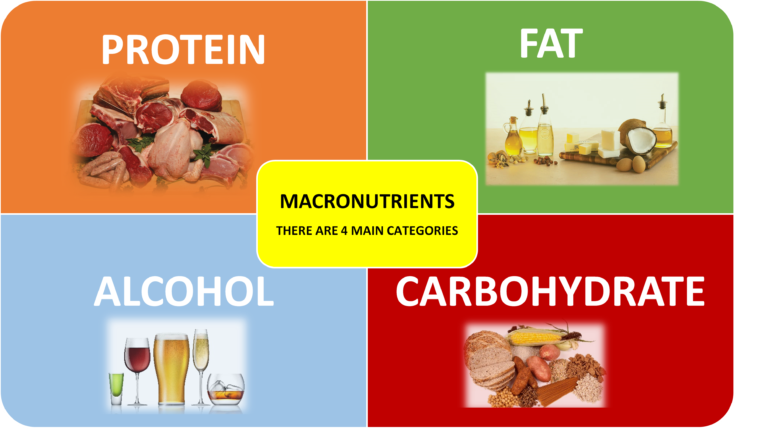
Macros? Micros? What the heck?...
I’m about to give you the short and ‘short’ of it (no typo’s here). Let’s not over complicate things and go into any long and convoluted detail. You can google the topic to get a more deep dive into macros. But here today, I will try to give you a couple of basic concepts to get you by.

"Macro" is an abbreviation
The first thing you need to know is that “macro” is actually short for “macronutrient”.
Macronutrients are types of nutrients that provide energy to your body in order for it to function as well as body repair for muscles and body tissues. Although many will say that there are only 3 macronutrient groups, being fat, protein and carbohydrates, I am an advocate for also including alcohol as it is calorie dense and for some, can contribute a significant amount of energy to their diets. And for those of you who are wondering, micronutrients, as opposed to macronutrients, are made up of vitamins and minerals that are required in generally small quantities to ensure normal growth, metabolism and physical health.
Each of these macronutrient groups has a calorie value.

Dietary fats contain fatty acids. Most people know these fatty acids as saturated fatty acids, monounsaturated fatty acids and polyunsaturated fatty acids, trans-fats and less commonly conjugated linoleic acids. In our food, they can come from many sources. You can find it in both animal products and plant based products although when picturing forms of fats, most people naturally think first of liquid oils, lard, tallow, butter and ghee, where the fats have been separated out from the original sources of animals or plants. In recent dietary history a fear of fat has emerged, but in actuality, we need fats as they help the body to absorb vitamins A, D, E and K. Eating the right kinds of fat provides us with essential fatty acids such as linoleic and linolenic acids that we need but can only get from external sources, and eating fat fills our fat cells to help insulate our bodies from heat fluctuations and trauma injury.
When the body becomes depleted of glucose, it will turn to its fat stores, that are converted into ketones, to use an alternative energy source.
Proteins in very basic terms contain amino acids and some other compounds such as carbon and hydrogen. The predominant sources of proteins are animal products such as red meat, poultry, fish, eggs as well as dairy products like cheese, cream, milk and yoghurt. It can also be obtained from plant-based sources such as beans, peas, nuts and seeds. There is also protein in some fruits and vegetables but these tend to be in smaller quantities.
The body uses protein to make enzymes, hormones, hair, nails and an array of body chemicals. It also uses protein to build and repair body tissues.
Dietary carbohydrates come from the foods that we eat and include starches, sugars (such as fructose, glucose and lactose), fibre, gums and celluloses. These tend to be found in fruits, vegetables, grains and other plants but in modern days it often comes from processed and non-natural foods such as soda pop, candy, cakes and crisps. Carbohydrates by form of glucose is the bodies preferred choice of energy fuel, however, when glucose is depleted and unavailable, the body will turn to fat stores that it converts into ketones, to fuel the body.
Alcohol is the result of a fermentation process and most people are familiar with these food sources as beverages such as wine, beer, cider, liqueurs, and hard liquor. It is considered an endotoxin where overconsumption can lead to alcohol-induced liver injury of alcohol induced fatty liver disease.
Consumption of alcohol is largely due to its social and mood altering traits but it is wise to be aware that over-consumption can lead to adverse effects on the body, particularly effecting the brain, heart, liver and pancreas all coupled with the high level of calories that accompany alcohol or the sugary drinks that they may be mixed with.
If it fits your macros
A person will burn or use up a certain amount of energy/calories per day. The amount of calories that a person burns can vary widely and is dependent on a number of factors such as physical activity, age and gender, sleep patterns and so on. The amount of energy we burn will continuously fluctuate up and down simply because the factors affecting energy consumption are never exactly the same on any given day.
Health, medical and science organisations provide recommended guidelines for an average caloric consumption for both men and women that should enable them to maintain a stable, healthy weight.
“If it fits your macros” tends to come into play when a person has decided on a macronutrient and calorie goal. They may have decided upon their specific ratios after consulting a health practitioner or dietician or they may have used one of the many macro and calorie calculators that can be found on the internet. These macro and calorie ratios can vary depending on individual goals e.g. wanting to gain weight, lose weight, gain muscle, maintain weight, improve overall health, regulate hormones, reduce cholesterol levels, etc.
If you are following a ketogenic diet, your macros will generally fall into a breakdown of:
- 5-10% of calories from Net Carbohydrates (net carbs are where fibre is subtracted from total carbohydrate intake)
- 60-75% of calories from Fat (often higher for medicinal ketogenic diets)
- 15-30% of calories from Protein
- 0% of calories from Alcohol
Once you have decided on your daily calorie goal, for example, 1600 calories per day and you have chosen your macronutrient ratios, for example 70% fat, 25% protein and 5% carbohydrate, it is then just a matter of tracking the foods you eat and checking them against your macro and calorie goals. In this example it would mean consuming about 125g fat, 100g protein and 20g carbohydrates from the foods you eat each day.
Although you could in theory do this the old fashioned way with pen and paper, it is much easier to use an online app or programme to do the recording of data and mathematical equations. These apps and programmes maintain a database of foods and ingredients that include their nutrient break-down. They allow you to enter your macro and calorie goals and then they tally up the nutrients and calories for the foods you log which enables you to keep track of whether you’re eating too much or too little of each macro or too many or too few calories.
So, in a nutshell, “if it fits your macros” is all about a person being able to eat whatever foods and beverages they like providing the macro and calorie amounts they contain fall within the goals the person has set.
